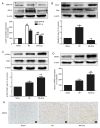Enalapril attenuates endoplasmic reticulum stress and mitochondrial injury induced by myocardial infarction via activation of the TAK1/NFAT pathway in mice
- PMID: 32010259
- PMCID: PMC6966191
- DOI: 10.3892/etm.2019.8280
Enalapril attenuates endoplasmic reticulum stress and mitochondrial injury induced by myocardial infarction via activation of the TAK1/NFAT pathway in mice
Abstract
The present study investigated the effect of enalapril on myocardial infarction (MI) and its mechanism of action in mice. Treatment with enalapril significantly attenuated cellular apoptosis and death. In vivo, enalapril treatment alleviated MI injury, and decreased myocardial apoptosis and the size of the infarct area. This was paralleled by increased Bcl-2 expression, decreased Bax expression, a decreased caspase-3 level, decreased expression of endoplasmic reticulum stress-associated proteins, including activating transcription factor 6 and 78 kDa glucose-regulated protein, and fewer TUNEL-positive cells in the heart. Furthermore, enalapril-treatment increased transforming growth factor-activated kinase 1/nuclear factor of activated T cells 3 signaling, which protected the myocardium.
Keywords: apoptosis; cardiac remodeling; enalapril; myocardial infarction; transforming growth factor-β–activated kinase 1/nuclear factor of activated T cells pathway.
Copyright: © Rong et al.
Figures




Similar articles
-
Resina draconis inhibits the endoplasmic-reticulum-induced apoptosis of myocardial cells via regulating miR-423-3p/ERK signaling pathway in a tree shrew myocardial ischemia- reperfusion model.J Biosci. 2019 Jun;44(2):53. J Biosci. 2019. PMID: 31180066
-
YiQiFuMai Powder Injection Attenuates Ischemia/Reperfusion-Induced Myocardial Apoptosis Through AMPK Activation.Rejuvenation Res. 2016 Dec;19(6):495-508. doi: 10.1089/rej.2015.1801. Epub 2016 May 18. Rejuvenation Res. 2016. PMID: 27072567
-
Berberine protects rat heart from ischemia/reperfusion injury via activating JAK2/STAT3 signaling and attenuating endoplasmic reticulum stress.Acta Pharmacol Sin. 2016 Mar;37(3):354-67. doi: 10.1038/aps.2015.136. Epub 2016 Jan 25. Acta Pharmacol Sin. 2016. PMID: 26806299 Free PMC article.
-
TAK1 Regulates Myocardial Response to Pathological Stress via NFAT, NFκB, and Bnip3 Pathways.Sci Rep. 2015 Nov 13;5:16626. doi: 10.1038/srep16626. Sci Rep. 2015. PMID: 26564789 Free PMC article.
-
MicroRNA-155 inhibition attenuates endoplasmic reticulum stress-induced cardiomyocyte apoptosis following myocardial infarction via reducing macrophage inflammation.Eur J Pharmacol. 2019 Aug 15;857:172449. doi: 10.1016/j.ejphar.2019.172449. Epub 2019 Jun 14. Eur J Pharmacol. 2019. PMID: 31207208
Cited by
-
Circ-SWT1 Ameliorates H2O2-Induced Apoptosis, Oxidative Stress and Endoplasmic Reticulum Stress in Cardiomyocytes via miR-192-5p/SOD2 Axis.Cardiovasc Toxicol. 2022 Apr;22(4):378-389. doi: 10.1007/s12012-022-09720-2. Epub 2022 Jan 31. Cardiovasc Toxicol. 2022. PMID: 35099761
-
PANoptosis: a potential target of atherosclerotic cardiovascular disease.Apoptosis. 2025 Jun;30(5-6):1253-1271. doi: 10.1007/s10495-025-02089-x. Epub 2025 Apr 26. Apoptosis. 2025. PMID: 40285923 Free PMC article. Review.
-
ER stress improvement by aerobic training or enalapril differently ameliorates pathological cardiac remodeling in obese mice.Mol Cell Biochem. 2024 Nov;479(11):3167-3179. doi: 10.1007/s11010-024-04925-1. Epub 2024 Feb 3. Mol Cell Biochem. 2024. PMID: 38308790
-
Shenqi Lixin Decoction improves cardiac function in rats with adriamycin-induced heart failure through modulation of PGC-1α and mitochondrial apoptosis pathway.Ann Transl Med. 2021 Oct;9(20):1592. doi: 10.21037/atm-21-5350. Ann Transl Med. 2021. PMID: 34790798 Free PMC article.
References
LinkOut - more resources
Full Text Sources
Research Materials
Miscellaneous
